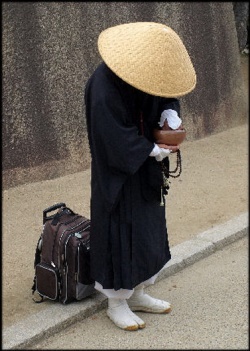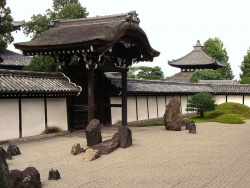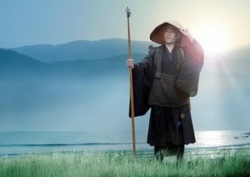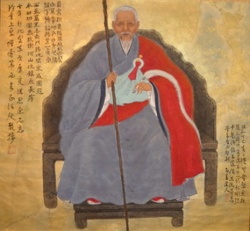The Nature of the Koan by Ross Bolleter
One of the most alluring aspects of Zen is the practice of Koans. Koans are a teaching tool, original to Zen, used to remove the barriers to enlightenment. They are a means to awaken to our true nature. Awakening to your true nature ––what the Japanese call kenshō (ken, to see, shō, truly)––is the first step on the path to enlightenment. In the experience of kenshō, the barriers between what we understand as the world, and what we understand as the self, come down a little ––or a lot––and, with this, you are never quite the same again. With this experience you begin to understand your relation to the cosmos in new ways, and are embarked on the path of liberation.
The koans which are used in this early phase of training to encourage the experience of awakening to your true nature are known as Dharmakaya koans, or koans that are primarily focused on emptiness. A cluster of these Dharmakaya koans forms what is commonly called the first barrier. Some examples are: Zhaozhou’s Mu, or “Who is hearing that sound?” or “What is the sound of one hand?” or “What is it?” or “What is my original face before my parents were born?” These koans are specifically concerned with awakening to emptiness – the unbounded state where we are intimate with the universe, and where the universe finds its expression as you.
After seeing into his or her true nature, the student deepens their experience through further koan work. Not getting stuck in a particular place, at a particular stage. This work enables the student to awaken to other aspects of the Zen Way, and to learn to express and embody their awakening. This is the path of deepening and maturing your awakening, and necessarily takes a long time.
Koan literarily translated means “public record.” “Public” (kō) refers to what is in common between us, “the single track followed by all the sages, the highest principle which serves as a Way for the world.” “Record” (an) refers to “orthodox writings that the sages regard as principles.” These formal implications of the word “koan” have analogies with legal records, legal precedents, which provide a reliable basis for judgement. This means that koans can be used to test the depth of the water, the depths of the students realization. When a student is stuck on a particular koan it also shows where they are blocked.
Norman Fischer: Also kō can mean light, a darkness. In this regard, the word kōan means “light- darkness” (the light of the darkness, the darkness of the light …). where “darkness” corresponds to emptiness, and “light” to uniqueness and differentiation.
Almost all of the koan literature is Chinese, and was developed during the Tang dynasty (7th to 10th century) and the Song dynasty (10th to the 13th centuries). Most of the great koan collections: The Blue Cliff Record, The Book of Equanimity, The Gateless Barrier were compiled during the Song dynasty. The Transmission of the Light was compiled with commentaries by Keizan Jokin early in the 14th century. Almost all of the koans are from Chinese sources.
Koans sometimes develop through dialogue between a Zen teacher and a student, or another teacher. Sometimes they are conveyed as a story, sometimes a poem: From a well that has never been dug, Water ripples in a spring that does not flow. Someone with no shadow or form is drawing the water.
Koans encode ultimate reality. To work with a koan is to open yourself to experience that reality. Koans can aid the student in finding the truth that transcends what Hakuun Yasutani calls the common delusion of humanity: that “I am in here,” while “you are out there.” Zen, especially through koans, works to dethrone this sense of a separated self. When the self is seen through as empty, we experience intimacy with all beings, and, with this experience, begin to walk the path of liberation.
With awakening, our delusions about the self and the nature of reality drop away, so that we can say that, in experiencing our original nature, nothing new is added. The moon has always been shining. When we experience our original nature, we are experiencing the world as if for the first time. The experience feels ancient, even timeless, as indeed it is.
Caveats: The view we awaken primarily through working with koans is the view of the Linji (Jap. Rinzai) tradition. This is only one half of the picture. The Caodong (Jap. Sōtō) tradition focuses, at least in its Japanese traditions, not on koans, but on Shikantaza – or “just sitting,” (literally, “nothing but precisely sitting.”) Implicit in Shikantaza is the consideration that we are enlightened from the beginning, and that there is no need to strive for awakening as something separate from our nature, as it reveals itself in our meditation, which is not less that our life.
Characteristics of the koan: Although koans can sometimes appear to be riddles, they aren’t subject to any kind of intellectual resolution, and are neither expressive of cleverness, nor responsive to it. Sometimes koans are paradoxical in their expression. Paradox and dilemma are in the service of the Middle Way, which is not some kind of a mean between extremes, but true nature as it unfolds here and now: timeless and timeful,in the same breath. What is the koan of your life?
How to work with a koan
Whatever arises by away of insight or understanding, you let go of. Regarding effort, use the energy you have. It’s like swimming underwater in the darkness. From time to time you get caught up in the water weed. You push it aside, glide for a while, renew the question as to the one who hears, and keep going.
After a time––it’s not clear how long––you are no longer aware of the silent avalanche of notions you once held dear. Eventually you reach a place where you are blocked; and can neither advance, nor retreat. In that place, you just renew your questioning.
You are like a dark ravine, a mysterious valley. It’s as if you are pregnant, but you can’t give birth. Everything waits, in a dark pause, aching to be breathed out, to come into life. You feel edgeless: it’s like looking into a mirror that shines back darkness only. The night moves on little feet, or big feet, depending.
It doesn’t make any sense to return to your koan – you just do, and then again. The deeper into the koan you go, the more you leave behind; the more you leave behind, the deeper you go.
After a long time, waiting wears itself out. You expect nothing. It is like walking out on a long jetty at night without being able to see your hand in front of your face, and hearing the sound of water lapping in the darkness.
This is beyond reason, and the Way gathers in darkness; it also gathers as your struggle to return to your koan, with sleep closing in. Mostly you don’t notice this gathering; in fact, most of the time you feel a bit desperate and wonder why you’re doing such an unreasonable, impossible practice.
If you’re questioned concerning your koan, you don’t know, and still you don’t know. It’s important to settle into that not knowing, which isn’t the blankness of ignorance, but rather, of a profound mystery that cannot find its tongue.
We encounter our doubts too. Doubts about whether we deserve the Way when there is so much suffering in the world; or if we’re enlightened from the beginning, why we have to sweat and struggle like this. And these doubts connect with our fears of failure.
At this stage of the journey, it doesn’t pay to get too interested in the spectres of failure. It’s good, too, not to be led about by our ideas about the great sea change we’re undergoing, either. Later, such preoccupations can be looked at in the light of the moon, and their root systems uncovered in the cultivation that continues after enlightenment.
The moon rises and reflects in the water in its own good time. Meanwhile, you come up to the gate a thousand times. When your time is ripe, under cover of darkness, you go through.
Source
Author: Ross Bolleter
buddhismandaustralia.com



